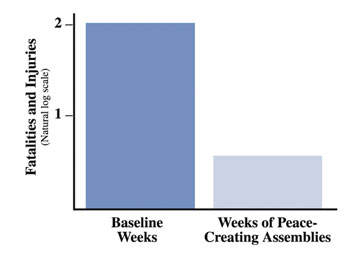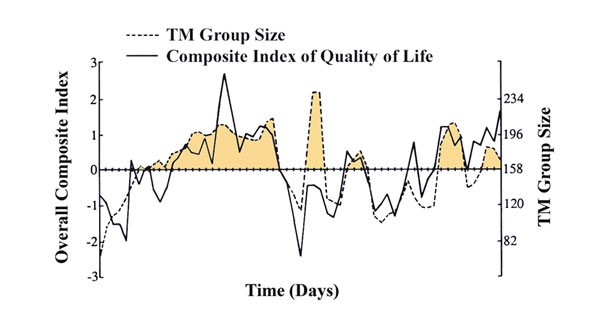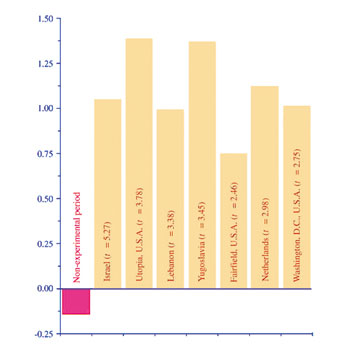Scientific Research: Peace
SCIENTIFIC RESEARCH ON THE CREATION OF PEACE
The unique effectiveness of the Consciousness-Based Approach to Peace in preventing social violence, terrorism, and war has been confirmed by more than 50 replications including 25 studies published in leading peer-reviewed scientific journals or conference proceedings. This research has been carefully scrutinized by independent scholars and accepted for publication in top academic journals (see references). In every case, this approach produced marked reductions of crime, social violence, terrorism, and war, and increased peace and positivity in society.
23 PUBLISHED STUDIES SHOW:
War fatalities reduced 71%
War injuries reduced 71%
Conflict level reduced 41%
Cooperation increased 66%
Decreased War and Terrorism
A critical experimental test of the Consciousness-Based Approach to Peace was conducted during the peak of the Lebanon war. A day-by-day study of a two-month assembly in Israel in 1983 showed that, on days when the number of participants in this Unified Field-based approach to defense (“TM Group Size,” right) was high, war deaths in neighboring Lebanon dropped by 76% (p < 10-7). In addition, crime, traffic accidents, fires, and other indicators of social stress in Israel (combined into a Composite Index) all correlated strongly with changes in TM group size. Other possible causes (weekends, holidays, weather, etc.) were statistically controlled for (Journal of Conflict Resolution 32: 776-812, 1988).
“THIS RESEARCH…DEMANDS ACTION”
“I have been following the research on the Maharishi Effect as it has developed over the last twenty years.
There is now a strong and coherent body of evidence showing that [this approach] provides a simple and cost-effective solution to many of the social problems we face.
This research and its conclusions are so strong, that it demands action from those responsible for government policy.”—Huw Dixon, Ph.D., Professor of Economics at York University, England
These results were subsequently replicated in seven consecutive experiments over a two-year period during the peak of the Lebanon war. The results of these interventions included:
• war-related fatalities decreased by 71% (p < 10-10)
• war-related injuries fell by 68% (p < 10-6)
• the level of conflict dropped by 48% (p < 10-8)
• cooperation among antagonists increased by 66% (p < 10-6)
The likelihood that these combined results were due to chance is less than one part in 1019, making this effect of reducing societal stress and conflict the most rigorously established phenomenon in the history of the social sciences (Journal of Social Behavior and Personality 17(1): 285–338, 2005).
 In addition, the global influence on terrorism of three large coherence-creating assemblies was studied retrospectively through an analysis of data compiled by the Rand Corporation. The data revealed a 72% reduction in worldwide terrorism during the three assemblies taken together, as compared to all other weeks during a two-year period. Each assembly had approached or exceeded the participation threshold (8,000) predicted to create a global influence of peace. The study ruled out the possibility that this reduction in terrorism was due to cycles, trends, or drifts in the measures used, or to seasonal changes (Journal of Offender Rehabilitation 36 (1-4): 283-302, 2003).
In addition, the global influence on terrorism of three large coherence-creating assemblies was studied retrospectively through an analysis of data compiled by the Rand Corporation. The data revealed a 72% reduction in worldwide terrorism during the three assemblies taken together, as compared to all other weeks during a two-year period. Each assembly had approached or exceeded the participation threshold (8,000) predicted to create a global influence of peace. The study ruled out the possibility that this reduction in terrorism was due to cycles, trends, or drifts in the measures used, or to seasonal changes (Journal of Offender Rehabilitation 36 (1-4): 283-302, 2003).
Decreased Crime and Social Stress
A National Demonstration Project conducted in Washington, D.C., from June 7 to July 30, 1993, tested the efficacy of the Consciousness-Based Approach to Peace for reducing crime and social stress and improving the effectiveness of government.
In this carefully controlled experiment, the coherence-creating group increased from 800 to 4,000 over the two-month period. Although violent crime had been steadily increasing during the first five months of the year, soon after the start of the study, violent crime (measured by FBI Uniform Crime Statistics) began decreasing and continued to drop until the end of the experiment (maximum decrease 23.3%), after which it began to rise again. The likelihood that this result could be attributed to chance variation in crime levels was less than two parts per billion (p < .000000002). The drop in crime could not be attributed to other possible causes, including temperature, precipitation, weekends, and police and community anti-crime activities (Social Indicators Research 47: 153-201, 1999).
These are just a few of the more than 50 scientific demonstrations and 23 published studies on this Consciousness-Based Approach to Peace. These studies are backed by more than 600 other published studies conducted at over 200 independent universities and research institutes in 30 countries on the individual and societal benefits of these Unified Field-Based, Consciousness-Based, technologies of consciousness. This extensive body of scientific research makes the unique approach of the Global Country of World Peace the most thoroughly tested and rigorously established peace-creating technology in the world today.



